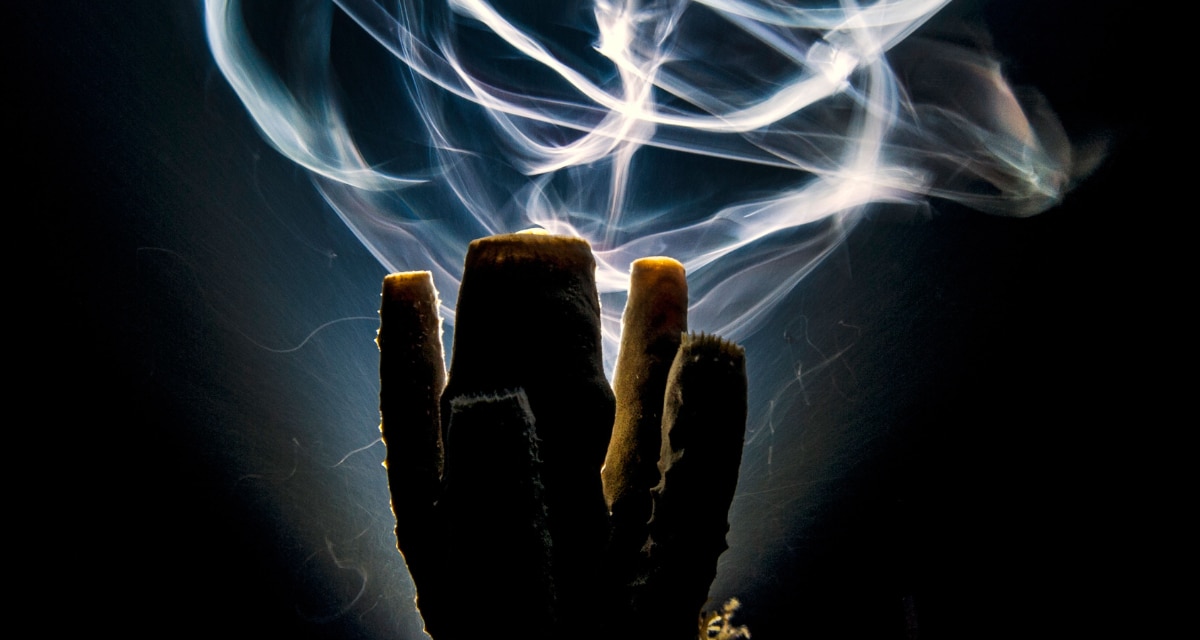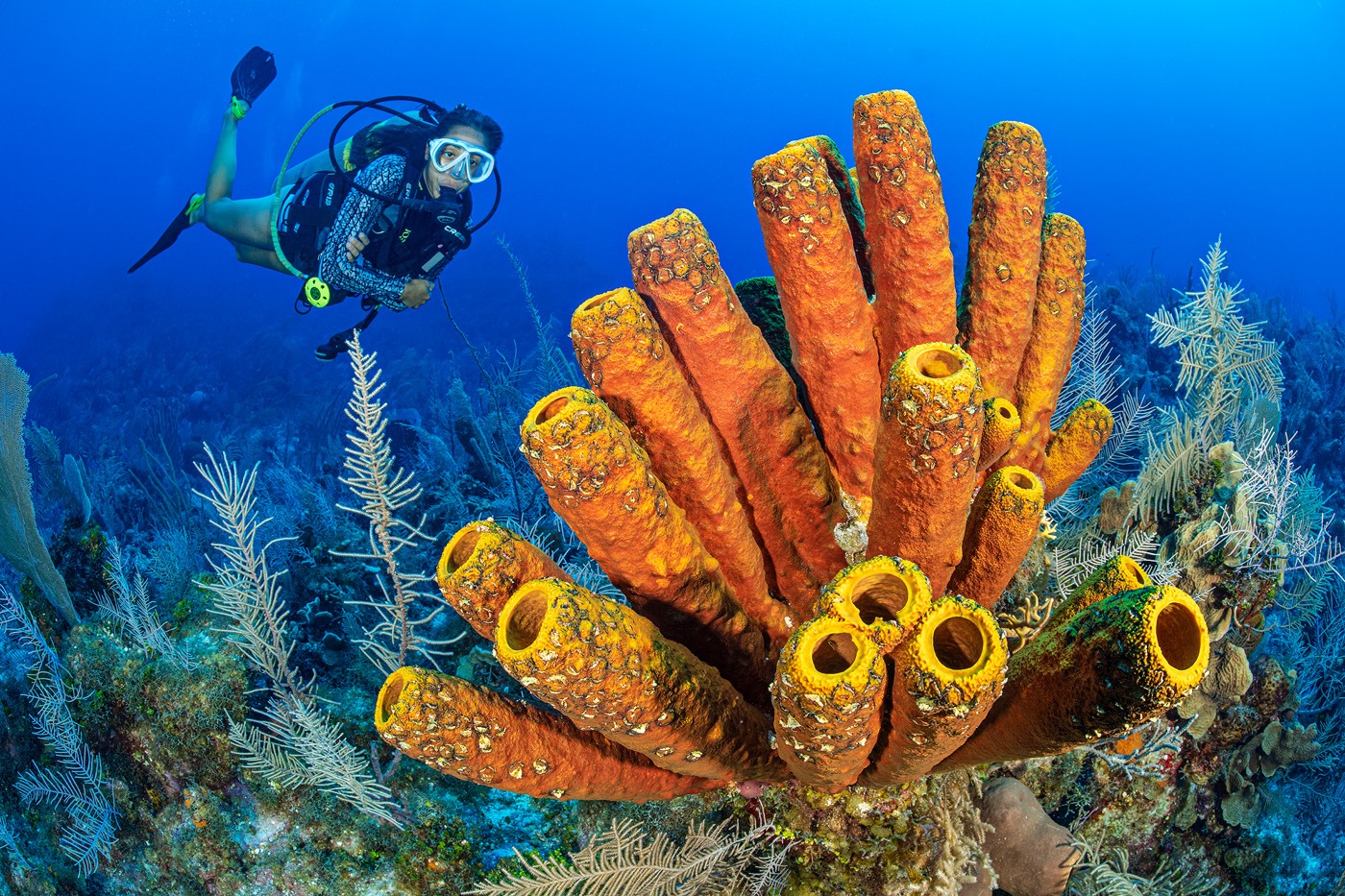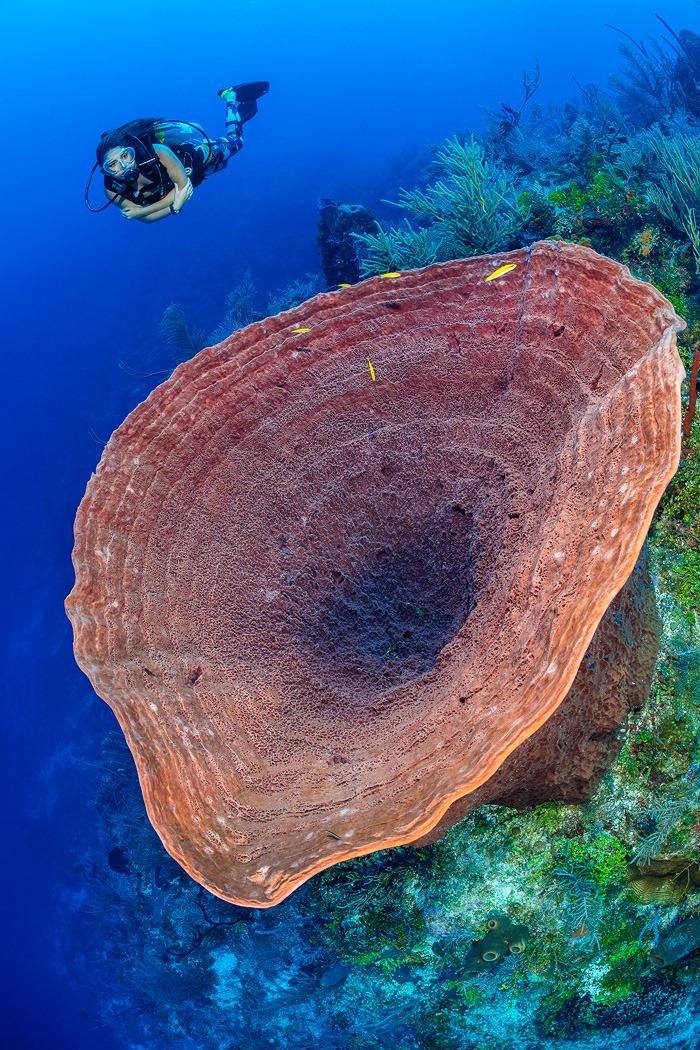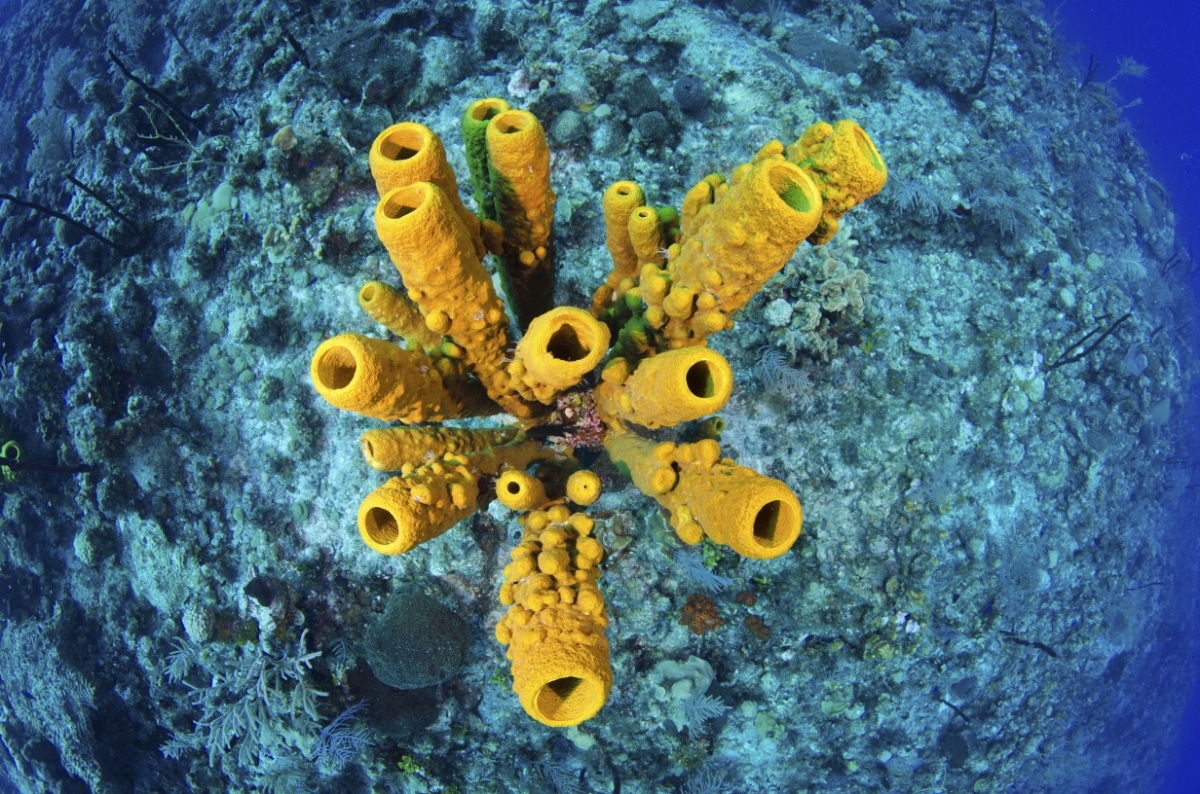News
There is no better time to enjoy Cayman’s wonderful world of sponges

As if the Cayman Islands didn’t already offer an amazing diving experience, fantastic sponge life is another reason to take a dive vacation there in 2020.
Divers who jump into any dive site in the Cayman Islands these days will witness sponges at the peak of their life cycle on local reefs. This means sponges are healthier, larger and more picturesque than they have been for more than a decade.
It has been 15 years since Hurricane Ivan struck the Cayman Islands and damaged the reefs destroying many of the sponges. The lack of storms since then has allowed them to grow back undisturbed. Alex Mustard, widely regarded as one of the world’s leading underwater photographers, photographs Cayman’s underwater world frequently and notes changes through the seasons.

Photo: Alex Mustard
“Hurricane Ivan levelled a lot of sponges on the north, east and south of the island, and I remember walking on Colliers beach straight after the storm and seeing loads and loads of sponges washed up,” he said. “A lot of them started re-growing then, and many have now reached maximum size and they look superb.”
“Sponges naturally fall off after they reach their maximum size and eventually regrow,” said Ocean Frontiers co-owner Steve Broadbelt, “but the hurricane wiped so many of them out at the same time. The quiet years have allowed them to reach maximum growth. It’s amazing to see them and we’re excited to show them to our visitors.”

Photo: Alex Mustard
Sponges attach themselves to the seafloor and filter water for food. These sea animals been around for thousands of years, and more than 6000 species of sponges can be found in oceans around the world. Cayman’s warm, clear and nutrient-rich water is ideal for Caribbean sponges and local reefs house more than 57 species in various colors. Among them; giant barrel sponges, orange elephant ear sponges, ball sponges, boring sponges, rope sponges and the rare antler sponge. If undisturbed, a giant barrel sponge can live 130 years. One of the largest sponges in Cayman is an elephant ear sponge on the west wall that measures 9 feet across.
Like corals, sponges play an important role in complex reef ecosystems. Boring and encrusting sponges compete for space with hard corals on the reef. Tube and barrel sponges give tiny goby fish a place to create their “cleaning stations.” Hawksbill turtles love to munch on the tough outer layer of barrel sponges, and angelfish feed on the soft inside of the sponge left behind by the turtles.
Steve Broadbelt says that sponges, like corals, also spawn during the year but not necessarily at the same time. Seasoned divers will have noticed. “Anyone who has been diving Cayman long enough will have seen sponges spawning at some point. This is the only time a sponge visually demonstrates that it is actually a living animal.”

Photo: Alex Mustard
Scientists believe life-saving drugs can be found in the ocean. From a large shallow water sponge in the 1950’s, scientists extracted two chemicals used to treat patients with cancer and now HIV. With much to learn about sponges and their relationship to other sea animals on the reef, there is concern about risks to their habitats; bottom trawling fishing, underwater cables, oil and gas exploration.
Underwater photographers give Cayman high marks for its picturesque reefs and drop-offs, its marine life and wrecks, and its warm, crystal clear water. The current splendor of its sponges is another reason to visit and document Cayman’s unbeatable underwater world.
Discover more about visiting and diving the Cayman Islands at www.visitcaymanislands.com
Grand Cayman also features in the WINTER 2020 issue of Scubaverse’s Dive Travel Adventures magazine – available at www.issuu.com/scubaverse soon!
Gear News
Scubapro Free Octopus Promotion 2024

Free Octopus with every purchase of a SCUBAPRO regulator system
Just in time for the spring season, divers can save money with the FREE OCTOPUS SPRING PROMOTION! Until July 31st SCUBAPRO offers an Octopus for free
with every purchase of a regulator system!
Get a free S270 OCTOPUS with purchase of these combinations:
MK25 EVO or MK19 EVO with A700
MK25 EVO or MK19 EVO with S620Ti
MK25 EVO or MK19 EVO with D420
MK25 EVO Din mit S620Ti-X
Get a free R105 OCTOPUS with purchase of the following combinations:
MK25 EVO or MK19 EVO with G260
MK25 EVO or MK17 EVO with S600
SCUBAPRO offers a 30-year first owner warranty on all regulators, with a revision period of two years or 100 dives. All SCUBAPRO regulators are of course certified according to the new European test standard EN250-2014.
Available at participating SCUBAPRO dealers. Promotion may not be available in all regions. Find an authorized SCUBAPRO Dealer at scubapro.com.
More information available on www.scubapro.com.
Blogs
Northern Red Sea Reefs and Wrecks Trip Report, Part 3: The Mighty Thistlegorm

Jake Davies boards Ghazala Explorer for an unforgettable Red Sea diving experience…
Overnight, the wind picked up, making the planned morning dive a bit bumpy on the Zodiacs to the drop point on Thomas Reef. There, we would dive along the reef before descending through the canyon and then passing under the arch before ascending the wall with a gentle drift. The site provided great encounters with more pelagic species, including shoals of large barracuda, tuna, and bigeye trevally.
Once back on the boat, it was time to get everything tied down again as we would head back south. This time, with the wind behind us, heading to Ras Mohammed to dive Jackfish Alley for another great gentle drift wall dive before then heading up the coast towards the Gulf of Suez to moor up at the wreck of the Thistlegorm. This being the highlight wreck dive of the trip and for many onboard, including myself, it was the first time diving this iconic wreck. I had heard so much about the wreck from friends, and globally, this is a must on any diver’s list. Fortunately for us, there was only one other boat at the site, which was a rarity. A great briefing was delivered by Ahmed, who provided a detailed background about the wreck’s history along with all the required safety information as the currents and visibility at the site can be variable.

Kitting up, there was a lot of excitement on deck before entering the water and heading down the shoreline. Descending to the wreck, there was a light northerly current which reduced the visibility, making it feel more like the conditions that can be found off the Welsh coast. At 10m from the bottom, the outline of the wreck appeared as we reached the area of the wreck which had been bombed, as our mooring line was attached to part of the propeller shaft. Arriving on deck, instantly everywhere you looked there were many of the supplies which the ship was carrying, including Bren Carrier tanks and projectiles that instantly stood out.

We headed around the exterior, taking a look at the large propeller and guns mounted on deck before entering the wreck on the port side to take a look in the holds. It was incredible to see all the trucks, Norton 16H, and BSA motorcycles still perfectly stacked within, providing a real snapshot in time.

Overall, we had four dives on the Thistlegorm, where for all of the dives we were the only group in the water, and at times, there were just three of us on the whole wreck, which made it even more special, especially knowing that most days the wreck has hundreds of divers. Along with the history of the wreck, there was plenty of marine life on the wreck and around, from big green turtles to batfish, along with shoals of mackerel being hunted by trevally. Some unforgettable dives.

The final leg of the trip saw us cross back over the Suez Canal to the Gobal Islands where we planned to stay the night and do three dives at the Dolphin House for the potential of sharing the dive with dolphins. The site, which included a channel that was teeming with reef fish, especially large numbers of goatfish that swam in large shoals along the edge of the reef. These were nice relaxing dives to end the week. Unfortunately, the dolphins didn’t show up, which was okay as like all marine life they are difficult to predict and you can’t guarantee what’s going to be seen. With the last dive complete, we headed back to port for the final night where it was time to clean all the kit and pack before the departure flight the next day.

The whole week from start to finish on Ghazala Explorer was amazing; the boat had all the facilities you need for a comfortable week aboard. The crew were always there to help throughout the day and the chefs providing top quality food which was required after every dive. The itinerary providing some of the best diving with a nice mixture of wreck and reef dives. I would recommend the trip to anyone, whether it’s your first Red Sea liveaboard in the Red Sea or you’re revisiting. Hopefully, it’s not too long before I head back to explore more of the Red Sea onboard Ghazala Explorer.

To find out more about the Northern Red Sea reef and wrecks itineraries aboard Ghazala Explorer, or to book, contact Scuba Travel now:
Email: dive@scubatravel.com
Tel: +44 (0)1483 411590
Photos: Jake Davies / Avalon.Red
-

 News3 months ago
News3 months agoHone your underwater photography skills with Alphamarine Photography at Red Sea Diving Safari in March
-

 News3 months ago
News3 months agoCapturing Critters in Lembeh Underwater Photography Workshop 2024: Event Roundup
-

 Marine Life & Conservation Blogs2 months ago
Marine Life & Conservation Blogs2 months agoCreature Feature: Swell Sharks
-

 Blogs2 months ago
Blogs2 months agoMurex Resorts: Passport to Paradise!
-

 Blogs2 months ago
Blogs2 months agoDiver Discovering Whale Skeletons Beneath Ice Judged World’s Best Underwater Photograph
-

 Gear Reviews3 months ago
Gear Reviews3 months agoGear Review: Oceanic+ Dive Housing for iPhone
-

 Marine Life & Conservation2 months ago
Marine Life & Conservation2 months agoSave the Manatee Club launches brand new webcams at Silver Springs State Park, Florida
-

 Gear Reviews2 weeks ago
Gear Reviews2 weeks agoGEAR REVIEW – Revolutionising Diving Comfort: The Sharkskin T2 Chillproof Suit
















